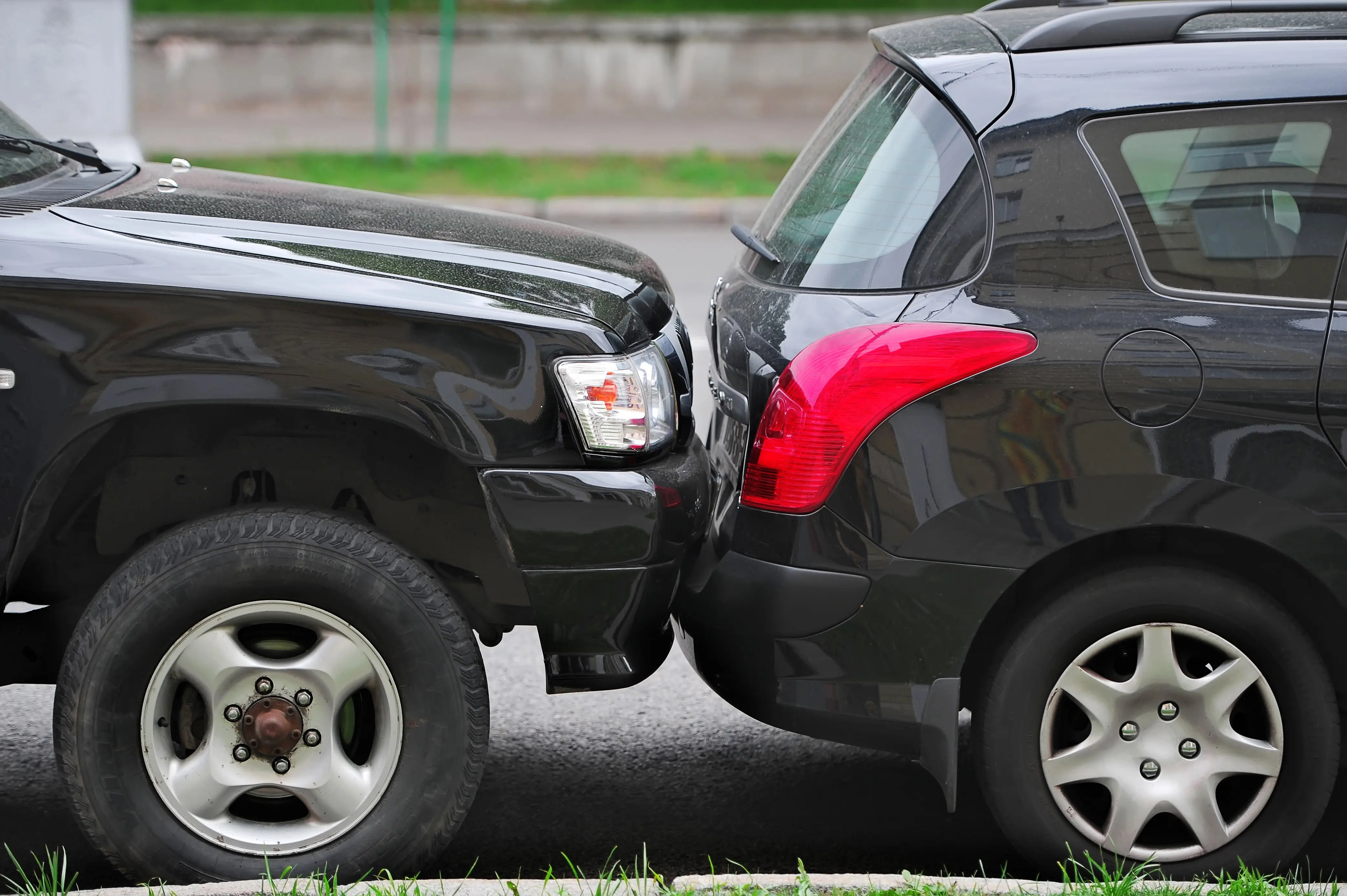Collision insurance pays to repair or replace your car if it’s damaged in a collision with another vehicle or object. This optional type of car insurance is typically purchased as part of a full coverage policy for around $165 a month.
You may also be able to purchase it as a standalone add-on to a liability policy from carriers like Progressive, Allstate, and Nationwide for an average of $140 a month.
What does collision insurance cover?
While your state-required liability insurance will cover damages that you cause to others in an accident, you’ll only be able to file an accident-related claim for your own vehicle repairs if your policy includes collision insurance.
What collision insurance does and doesn’t cover
| Does cover: | Does not cover: |
|---|---|
| An accident with another car | Hitting an animal |
| Hitting a stop sign, guardrail, telephone pole, or pothole | Falling objects |
| Flipping your car | Theft |
| Driving into a ditch | Other drivers’ damages |
Collision insurance will pay for damages to your vehicle regardless of who is determined to be at fault. That said, if another driver is found at fault for the accident, their liability insurance should be the primary auto coverage for your property damages.
Is collision insurance required?
Collision coverage is never mandated as part of any state’s minimum insurance requirements, but if you lease your car or you have a car loan, your lender may require you to carry full coverage insurance as part of your financing agreement.
But even if you’re not required to carry it, collision insurance is almost always a good investment. According to the Insurance Information Institute (III), in 2022 the average cost of an auto repair claim after a car accident was $5,992. If you were in an accident without collision coverage, you’d have to pay for those car repairs yourself.1
How much does collision coverage cost?
Although you may be able to buy collision coverage as a standalone add-on to liability insurance, it’s more cost-effective to buy it bundled with comprehensive coverage.
Cost of collision insurance as part of full coverage
Collision insurance is typically sold as part of a full coverage policy, which also includes liability and comprehensive coverage. On average, a full coverage insurance policy costs about $165 a month.
To learn more about the cost of full coverage insurance, Jerry’s experts analyzed thousands of real car insurance policies purchased by our customers. Based on their findings, here’s what drivers pay on average each month for full coverage with some of the nation’s top insurance companies.
| Insurance company | Full coverage |
|---|---|
| AAA | $215 |
| Allstate | $198 |
| Assurance America | $275 |
| Bristol West | $361 |
| Clearcover | $130 |
| Nationwide | $155 |
| Progressive | $178 |
| State Auto | $200 |
Cost of liability plus collision-only
Some insurance companies, like Progressive, Allstate, and Nationwide, will allow you to purchase a policy that only includes liability and collision insurance while excluding comprehensive coverage.
Our experts found that on average, a policy that contains only liability and collision costs an average of $140 a month. Here’s how that breaks down across some of the nation’s top insurance providers.
| Insurance company | Liability + Collision |
|---|---|
| Allstate | $233 |
| Aspire | $144 |
| Bristol West | $151 |
| Clearcover | $76 |
| Dairyland | $92 |
| Nationwide | $150 |
| Progressive | $127 |
Not all insurance companies will allow you to purchase collision insurance without comprehensive insurance, so be sure you review your coverage details when you’re comparing new quotes. Additionally, keep in mind that if your lender requires you to carry full coverage, you won’t be able to drop comprehensive until your loan or lease is paid off.
How are collision and comprehensive coverage different?
Collision covers damages to your vehicle after a collision-related event, while comprehensive pays for damage that isn’t related to a collision with another vehicle or stationary object, including:
- Fires and natural disasters (e.g., tornadoes, hurricanes, floods)
- Falling objects
- Theft and vandalism
- Severe weather (e.g., hailstorms, falling branches)
- Civil disturbances and riots
- Explosions
Should I buy collision-only and skip comprehensive?
You might consider skipping comprehensive coverage to keep your insurance costs low if you believe your vehicle has a low chance of being stolen or damaged by severe weather or falling objects. But it may not actually save that much money when you break down the numbers.
According to the III, the average cost of a comprehensive claim in 2022 was $2,738.2
Full coverage insurance costs an average of $165 a month, and liability plus collision costs an average of $140 a month. Given that it’s only an extra $15 a month on average to have comprehensive coverage, it’s likely worth it to protect you from unexpected vehicle repairs that don’t result from a car accident.
Collision coverage requires a deductible
When you purchase a car insurance policy that includes collision coverage, you’ll be able to set a deductible. If you have to file a claim, you’ll have to pay this deductible before your insurance provider will pay for your covered loss.
Your deductible amount plays a key role in the cost of your collision insurance. If you choose a lower deductible, you’ll pay less out of pocket when you file a claim, but your insurance rates will be higher. Conversely, if you choose a higher deductible, you’ll pay less in insurance premiums, but you’ll pay more if you have to file a claim.
Based on our experts’ analysis, here’s how the cost of your full-coverage policy changes based on your deductible amount:
| Insurance company | $500 deductible | $1,000 deductible | $2,500 deductible |
|---|---|---|---|
| AAA | $270 | $264 | $255 |
| Allstate | $241 | $228 | $224 |
| Nationwide | $185 | $181 | $179 |
| Progressive | $193 | $184 | $179 |
| State Auto | $224 | $218 | $213 |
Consider your deductible before you file a claim
If you have a minor accident, repair costs may be minimal—in fact, they may not even cost as much as your deductible. Jerry’s experts have some advice for how to use your deductible to determine if filing a claim is worth your time and money.
If you get into a collision, the circumstances of the accident will largely determine whether you should file a claim. If the other driver was at fault, their liability insurance should act as the primary policy to cover your repair costs. However, you might file with your collision insurance if:
- You were at fault
- The other driver had car insurance coverage, but it didn’t cover all of your repairs
- The other driver left the scene of the accident
Keep in mind:Filing a claim could increase your insurance rates for about 3 to 5 years—especially if the damage was due to an at-fault accident.
If the damage to your vehicle is less than (or only slightly more than) your deductible, you’ll be better off paying for the repairs out of pocket.
Collision deductible waiver (CDW)
Collision coverage requires you to pay a deductible even if someone else was at fault for an accident. However, in some states, you can purchase a collision deductible waiver (CDW).
Collision deductible waivers are currently only offered state-wide in California and Massachusetts, although some providers do offer similar coverage in other states.
With a CDW, you may not have to pay your deductible if an uninsured driver causes an accident and you have to file a claim with your own insurance company. A CDW may not apply if you’re the victim of a hit-and-run.
Do you need collision insurance coverage?
Generally speaking, most drivers can benefit from having collision coverage. It’s a no-brainer if you own a new car or an expensive vehicle, and it’s mandatory if you’ve financed or leased your car. And if the cost of repairing or replacing your car would put you in a bind, the peace of mind you get with collision coverage is well worth the price.
But it may not be worth it if your car isn’t worth much. Here’s why:
Your collision insurance will only pay out up to the actual cash value (ACV) of your vehicle. If your car is older or has a lower value, you might not receive much for a collision claim after you pay your deductible, so it may not be worth paying for collision insurance if you own the car outright.
For instance, if the value of your car is around $2,000 and you have a deductible of $1,000, the most you could receive from a total loss claim would be $1,000—you’d basically break even after paying your deductible.
Considering the cost of a full coverage policy works out to around $1,984 a year, you could just save what you would spend on the additional premium and your deductible and put it toward repairing or replacing your car.
When you’ll need collision coverage
- You own a newer or higher-value car
- You’re still paying off your car loan
- You drive frequently or live in a high-traffic area
- Paying out-of-pocket for repair or replacement costs would cause financial hardship
When you might not need collision coverage
- You own an older car with a low market value
- The cost of coverage exceeds the value of your vehicle
- You can afford out-of-pocket repairs
- Your vehicle is in long-term storage
How to save on collision insurance
Since car insurance companies calculate the cost of insurance differently, your rate might be higher or lower than the average. The only way to make sure you’re getting the best rate is to compare car insurance quotes from multiple providers. With the Jerry app, you can instantly compare rates from dozens of insurance companies.
FAQ
-
Which person would benefit from having collision coverage?
-
Is collision coverage better than full coverage?
-
Should I have collision coverage on a 10-year-old car?
-
What is the best coverage to have for auto insurance?
-
Will collision insurance cover water damage?
-
How much collision coverage do you need?
Sources
- https://www.iii.org/fact-statistic/facts-statistics-auto-insurance ↩︎
- https://www.iii.org/fact-statistic/facts-statistics-auto-insurance ↩︎

Expert insurance writer and editor Amy Bobinger specializes in car repair, car maintenance, and car insurance. Amy is passionate about creating content that helps consumers navigate challenges related to car ownership and achieve financial success in areas relating to cars. Amy has over 10 years of writing and editing experience. After several years as a freelance writer, Amy spent four years as an editing fellow at WikiHow, where she co-authored over 600 articles on topics including car maintenance and home ownership. Since joining Jerry’s editorial team in 2022, Amy has edited over 2,500 articles on car insurance, state driving laws, and car repair and maintenance.

Sarah Gray is an insurance writer with nearly a decade of experience in publishing and writing. Sarah specializes in writing articles that educate car owners and buyers on the full scope of car ownership—from shopping for and buying a new car to scrapping one that’s breathed its last and everything in between. Sarah has authored over 1,500 articles for Jerry on topics ranging from first-time buyer programs to how to get a salvage title for a totaled car. Prior to joining Jerry, Sarah was a full-time professor of English literature and composition with multiple academic writing publications.





